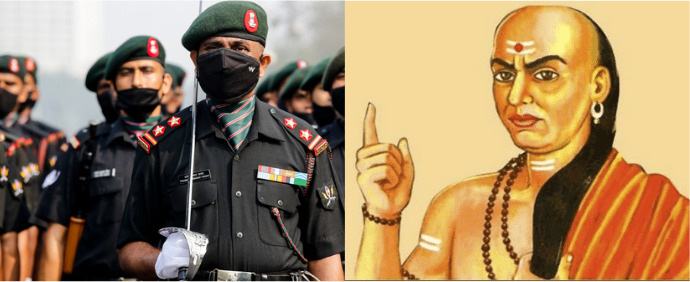A long-overdue step is finally being taken. A respectable country does not shy away from embracing its glorious history. India, however, under the so-called ‘secular’ way of life since independence has continually discounted ancient cultural glories, which date back by several millennia. What India lacked for the past 75 years was the political will to proudly embrace its heritage and root the idea of “modern India” firmly in where we as a civilisation have come from. With the Modi government, things are changing, and they are changing fast. So, the Indian military establishment is now actively considering the proposal of including ancient texts like the Bhagavad Gita and Arthshastra in the current military training curriculum.
The Proposal
- According to News18, a recent internal study conducted by the College of Defence Management (CDM) recommended exploring ways of incorporating ‘relevant teachings’ from ancient Indian texts such as Kautilya’s (Acharya Chanakya’s) Arthashastra and Bhagavat Gita into the current military training curriculum.
- The study also recommended establishing an ‘Indian Culture Study Forum’ and a dedicated facility to explore this possibility.
- The College of Defence Management (CDM) is a premier tri-services military training institution, where senior officers from the Military, Navy and the Indian Air Force are trained for higher defence management. Located in Secunderabad, Telangana, CDM has titled the report, “Attributes of Ancient Indian Culture and Warfare Techniques and its incorporation in present-day strategic thinking and training”.
- It is also reported that the project was sponsored by Headquarter Integrated Defence Staff.
- Quoting anonymous sources, News18 stated that the proposal aimed to research select ancient Indian scriptures with the view of exploring the possibility of incorporating them in the context of strategic thinking and leadership in the Indian Armed Forces.
- Apart from the Arthshastra and Bhagavad Gita, the CDM’s study also focused on the Thirukurral. Furthermore, it also recommended that research work be carried out over the next two years on the Manusmriti, Nitasara and Mahabharata.
The Significance
Finally, India is not shying away from incorporating ancient knowledge about warfare and statecraft into its modern military training curriculum. It was ignored for so long as Hindu culture as a whole became a political taboo for ‘secular’ governments. Under the present dispensation, however, the value of ancient Hindu texts is being unleashed. Before 2014, who would have thought the Indian military too could have ancient texts of Bharat as a part of their training curriculum?
Moreover, it is not only important but also necessary to include texts like Arthshastra and Bhagavad Gita in military studies. Both of these pieces of literature are considered to be the basis for warfare, especially in the Indian context. Arthshastra is still considered an ideal example in the eyes of modern historians in politics and warfare. Acharya Chanakya, the author of Arthshastra laid the foundation for the dream of ‘Akhand Bharat’, while emperor Chandragupta Maurya also helped a lot in fulfilling it.
Chanakya was a fourth-century (BCE) philosopher, teacher, economist, jurist and royal advisor, who built the Mauryan Empire along with his disciple Chandragupta Maurya. The Mauryan empire was one of the most powerful empires that ever existed in India, with boundaries ranging from modern-day Iran to Myanmar and Kashmir to Kerala.
The title Arthashastra is often translated to “the science of wealth”, however, it is so much more than just that. It includes lessons on the nature of government, law, civil and criminal court systems, ethics, economics, markets and trade, the methods for screening ministers, diplomacy, theories on war, nature of peace, and the duties and obligations of a king. What is best about this text is that it is rooted in Hindu philosophy.
The Bhagavad Gita is not only religiously and spiritually important, but is also the best guide for military strategists, officers and soldiers from the point of view of war. The text, which contains the teachings of Lord Krishna on the battlefield, can help India’s military in viewing our current geopolitical realities with a whole new lens entirely.
Backdrop
The proposal to include ancient Hindu texts in the training curriculum of the Indian military comes in the backdrop of Prime Minister Narendra Modi, in March this year, while seeking greater indigenisation in the national security apparatus of the country, including in procuring military equipment as well as in the doctrines and customs of the Armed Forces. PM Modi was speaking at the Combined Commanders Conference in Gujarat’s Kevadia, where two different sessions on the Indianisation of traditions and culture in the Armed Forces were held.
It is therefore the Modi government that is ensuring that the Indian military learns the best out of India’s ancient heritage and literature. The results of the same will be visible very soon, as India returns to the glories of the past by steadfastly taking inspiration from its heritage.
